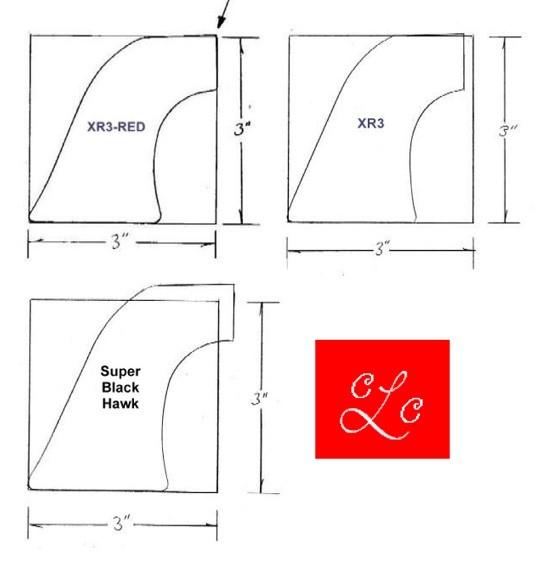Bob Wright said:
I beg to differ with y'all, but the XR-3 grip frame was the earliest grip frame used on Blackhawks, and closely matched the Colt SAA grip. Around 1963 or so the grip frame was redesigned to move the grip slightly further back and provide more room behind the trigger guard. This is the XR-3RED that has been used since that time, and, up until recently, was the standard Blackhawk grip frame.
Photo credit: Cary C
Bob Wright
Bob,
Now I know which you were referring to: the old models which are actually #XR3-RED and #XR3. Notice how they are written in Cary's sketch. You just got the dash locations mixed up. Those old numbers don't apply to NM grip frames, they have new #s. For example the NM #XR-3 is the short steel frame for the .32 Vaqueritos, and the large steel frame for a Blackhawk, therefore is not the same as the OM XR3. For NMs I use XR3-RED 'size' and the XR3 'size' frames. The NM vaqueros and Flattops are XR3 'size'. Here's the NM steel grip frames section of my chart with the new #s so we're not talking apples and oranges:
STEEL GRIP FRAME IDENTIFICATION NUMBERS (Founder's Marks) CAST ON GRIP FRAMES (N/A to Bearcat)
Notes: Most all grip frames are 1/2" thick unless otherwise noted below.
For convenience, NM frames in the two most common sizes are often referred to by their old model #s as XR3 'SIZE' or XR3-RED 'SIZE' but they have their own Casting numbers.
NM BLUE: STEEL GFs:
Small steel (OM #XR3 size) 1/8" closer to trigger guard than XR3-RED size, (cut for indexing pawl system, no extensions into main frame & only 7/16" thick) = A (in a square), no other marking observed; w & w/o lock. New Vaq w/o lock has a 512 prefix serial #, locks discontinued in 2012
Large steel (OM #XR3-RED size): Early = A (in a square) XR-3 (that's XR dash 3), Late = A in circle XR-3 1 in circle
Large alloy (OM #XR3-RED size) w/o lock: Early = NXR3-RED, Late = XRN-3RED. With lock = XR & L, locks discontinued in 2012
Short steel 'Vaquerito' .32s (3/16" shorter in length than the XR3 and XR3-RED sizes) = A (in a square) XR-3. If ordered as a separate part = 302 A (in a square)
Yes the lugs (good name for them) is what I was referring to in my first post: "The current Vaquero and Flat Top grip frames do not have supports that fit into grooves in the back of the main frame."
Any grip frame that has the lugs will fit any main frame that has the slots for the lugs.
If the main frame doesn't have slots for the lugs, just cut the lugs off he grip frame. Done this several times. Those were designed for the original alloy grip frames used on all Rugers including the first steel SBH introduced 1959.The lugs continued until 2005 on the NV and N Flattop. They are not needed for steel grip frames.




